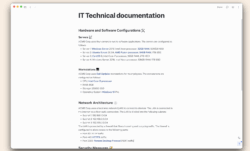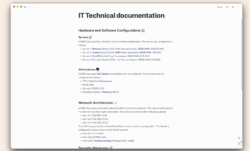Starting a new project can feel like embarking on an exciting adventure. But amidst the brainstorming and planning, it’s easy to overlook a crucial element: documentation. We often think, “Let’s just get started!”, but without proper documentation, your project can quickly become a tangled web of tasks, deadlines, and unclear responsibilities. Imagine trying to build a house without blueprints – that’s what it’s like running a project without clear documentation. Fortunately, you don’t need complex systems. A simple project documentation template can save you time, reduce confusion, and ensure everyone’s on the same page.
Think of project documentation as your project’s instruction manual, user guide, and historical record all rolled into one. It’s not about creating mountains of paperwork; it’s about capturing the essential information that will help you successfully execute your project from start to finish. This includes defining project goals, outlining tasks, assigning responsibilities, tracking progress, and managing risks. A well-documented project is a project that’s easier to manage, easier to communicate, and ultimately, more likely to succeed.
In this article, we’ll explore the importance of project documentation and how a simple project documentation template can streamline your workflow. We’ll delve into the key elements of a useful template and provide practical tips for creating one that works for you. We’ll also address common misconceptions about project documentation and show you how to avoid the pitfalls that can lead to wasted time and effort. So, let’s dive in and discover how a simple template can transform your project management approach.
Why is Project Documentation So Important?
Project documentation often feels like an extra chore, something you do when you have “extra time” (which, let’s be honest, rarely happens). However, neglecting proper documentation can lead to significant problems down the line. Without a clear record of your project’s goals, tasks, and decisions, you risk misunderstandings, duplicated efforts, and ultimately, project failure. Think of it as building a bridge without a detailed plan – you might get somewhere, but the chances of it collapsing are significantly higher.
One of the biggest benefits of good documentation is improved communication. A well-defined project document serves as a central source of truth, ensuring that everyone involved has access to the same information. This eliminates confusion, reduces the need for endless meetings, and fosters a more collaborative and productive environment. When team members can easily access the project’s objectives, tasks, and deadlines, they’re better equipped to contribute effectively and stay aligned with the overall goals.
Furthermore, project documentation helps with knowledge transfer. As team members come and go, or when new individuals join the project, comprehensive documentation ensures that valuable knowledge isn’t lost. Newcomers can quickly get up to speed by reviewing the documentation, understanding the project’s history, and learning about past decisions and challenges. This continuity is especially crucial for long-term projects or those involving complex processes.
Another critical aspect of project documentation is risk management. By documenting potential risks and mitigation strategies, you can proactively address challenges before they derail your project. This includes identifying potential obstacles, assessing their impact, and developing contingency plans to minimize their effects. A well-documented risk management plan helps you anticipate problems, make informed decisions, and keep your project on track, even when unexpected issues arise.
Finally, a simple project documentation template helps in project evaluation and learning. At the end of a project, you can review the documentation to assess what worked well, what could have been improved, and what lessons were learned. This feedback loop is essential for continuous improvement, allowing you to refine your project management processes and increase your chances of success in future endeavors. Think of it as learning from your past mistakes, so you don’t repeat them in the future.
Essential Elements of a Simple Project Documentation Template
Creating an effective project documentation template doesn’t have to be complicated. The key is to focus on the essential elements that will provide the most value for your team. A simple project documentation template should be easily accessible, easy to understand, and tailored to the specific needs of your project. It’s not about creating a rigid, bureaucratic process; it’s about providing a flexible framework that supports effective communication and collaboration.
One of the most important elements is a clear definition of project goals and objectives. What are you trying to achieve with this project? What are the specific, measurable, achievable, relevant, and time-bound (SMART) goals that will define success? Documenting these goals at the outset will provide a clear direction for the project and help keep everyone focused on the desired outcomes. It also helps to have a dedicated section for outlining the project scope. This includes defining the boundaries of the project, specifying what is included and excluded, and identifying any limitations or constraints.
Task assignments and responsibilities should be clearly documented. For each task, specify who is responsible for completing it, what the expected deliverable is, and when it is due. This ensures accountability and helps prevent tasks from falling through the cracks. A simple task management system within your documentation can be incredibly helpful. Consider using a table or a simple checklist to track tasks, assignees, deadlines, and completion status.
Documenting communication protocols is also essential. How will the team communicate? How often will progress updates be shared? Who is responsible for disseminating information? Establishing clear communication channels and protocols will help prevent misunderstandings and ensure that everyone stays informed. A simple communication plan can outline preferred methods of communication (e.g., email, instant messaging, project management software) and frequency of updates.
Lastly, including a change management process can be helpful. Projects rarely go exactly as planned, so it’s important to have a process for managing changes to the project scope, timeline, or budget. Documenting the change management process ensures that changes are properly evaluated, approved, and communicated to all stakeholders. A simple change request form can capture the details of proposed changes, their impact on the project, and the rationale for approval or rejection.
Ultimately, the best project documentation is the documentation that gets used. So, keep it simple, make it accessible, and tailor it to the specific needs of your project and team.
Effective project documentation serves as the backbone of a successful project, guiding the team and ensuring everyone is on the same page. It’s an investment that pays dividends in the form of reduced confusion, improved communication, and increased efficiency.
By embracing a simple project documentation template, you empower your team to collaborate effectively, manage risks proactively, and achieve their project goals with greater confidence. So, take the time to create a template that works for you, and watch your projects thrive.


